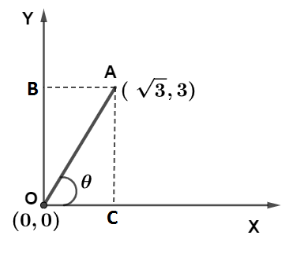
A particle starting from the origin $(0,0)$ moves in a straight line in the x-y plane.Its coordinates at a later time are \[(\sqrt 3 ,3)\]. The path of particle makes with x axis at an angle of
A. $30^\circ $
B. $60^\circ $
C. $45^\circ $
D. $0^\circ $
Answer
492k+ views
Hint: In order to solve this question we need to understand the straight line definition which states that a straight line is a path traced by particles in moving from one point to another such that direction of motion is constant. We can derive a straight line equation of the body by finding slope or the angle from the x axis which is made while moving.
Complete step by step answer:
According to the given problem, let the origin be denoted by point $O$ and at a later time its position denoted by point $A$. So connecting these two points we get a straight line making an angle $\theta $ with an $x$ axis.

Since the coordinate of point A is $(\sqrt 3 ,3)$
Hence OC is $\sqrt 3 $ and OB is $3$
Now since the vector can be linearly translated so $OB = AC$
Now in triangle $\Delta OAC$ from trigonometry we have $\tan \theta = \dfrac{{AC}}{{OC}}$
$\tan \theta = \dfrac{3}{{\sqrt 3 }} = \sqrt 3 $
So inverting it we get $\theta = {\tan ^{ - 1}}(\sqrt 3 ) = 60^\circ $
So the correct option is B.
Note: It should be remembered that this problem could also be solved using a straight line equation that is $y = mx$ where “m” is slope of line or tangent of angle which it makes with x axis. Also slope is defined as derivative of equation $y = mx$ which can simply written as $m = \dfrac{{dy}}{{dx}}$ where $dy$ is the change in magnitude of parameter on y axis while between two points and similarly $dx$ is the change in magnitude of parameter on x axis between two points.
Complete step by step answer:
According to the given problem, let the origin be denoted by point $O$ and at a later time its position denoted by point $A$. So connecting these two points we get a straight line making an angle $\theta $ with an $x$ axis.

Since the coordinate of point A is $(\sqrt 3 ,3)$
Hence OC is $\sqrt 3 $ and OB is $3$
Now since the vector can be linearly translated so $OB = AC$
Now in triangle $\Delta OAC$ from trigonometry we have $\tan \theta = \dfrac{{AC}}{{OC}}$
$\tan \theta = \dfrac{3}{{\sqrt 3 }} = \sqrt 3 $
So inverting it we get $\theta = {\tan ^{ - 1}}(\sqrt 3 ) = 60^\circ $
So the correct option is B.
Note: It should be remembered that this problem could also be solved using a straight line equation that is $y = mx$ where “m” is slope of line or tangent of angle which it makes with x axis. Also slope is defined as derivative of equation $y = mx$ which can simply written as $m = \dfrac{{dy}}{{dx}}$ where $dy$ is the change in magnitude of parameter on y axis while between two points and similarly $dx$ is the change in magnitude of parameter on x axis between two points.
Recently Updated Pages
Master Class 12 Business Studies: Engaging Questions & Answers for Success

Master Class 12 Economics: Engaging Questions & Answers for Success

Master Class 12 English: Engaging Questions & Answers for Success

Master Class 12 Maths: Engaging Questions & Answers for Success

Master Class 12 Social Science: Engaging Questions & Answers for Success

Master Class 12 Chemistry: Engaging Questions & Answers for Success

Trending doubts
What is meant by exothermic and endothermic reactions class 11 chemistry CBSE

Which animal has three hearts class 11 biology CBSE

10 examples of friction in our daily life

One Metric ton is equal to kg A 10000 B 1000 C 100 class 11 physics CBSE

1 Quintal is equal to a 110 kg b 10 kg c 100kg d 1000 class 11 physics CBSE

Difference Between Prokaryotic Cells and Eukaryotic Cells




